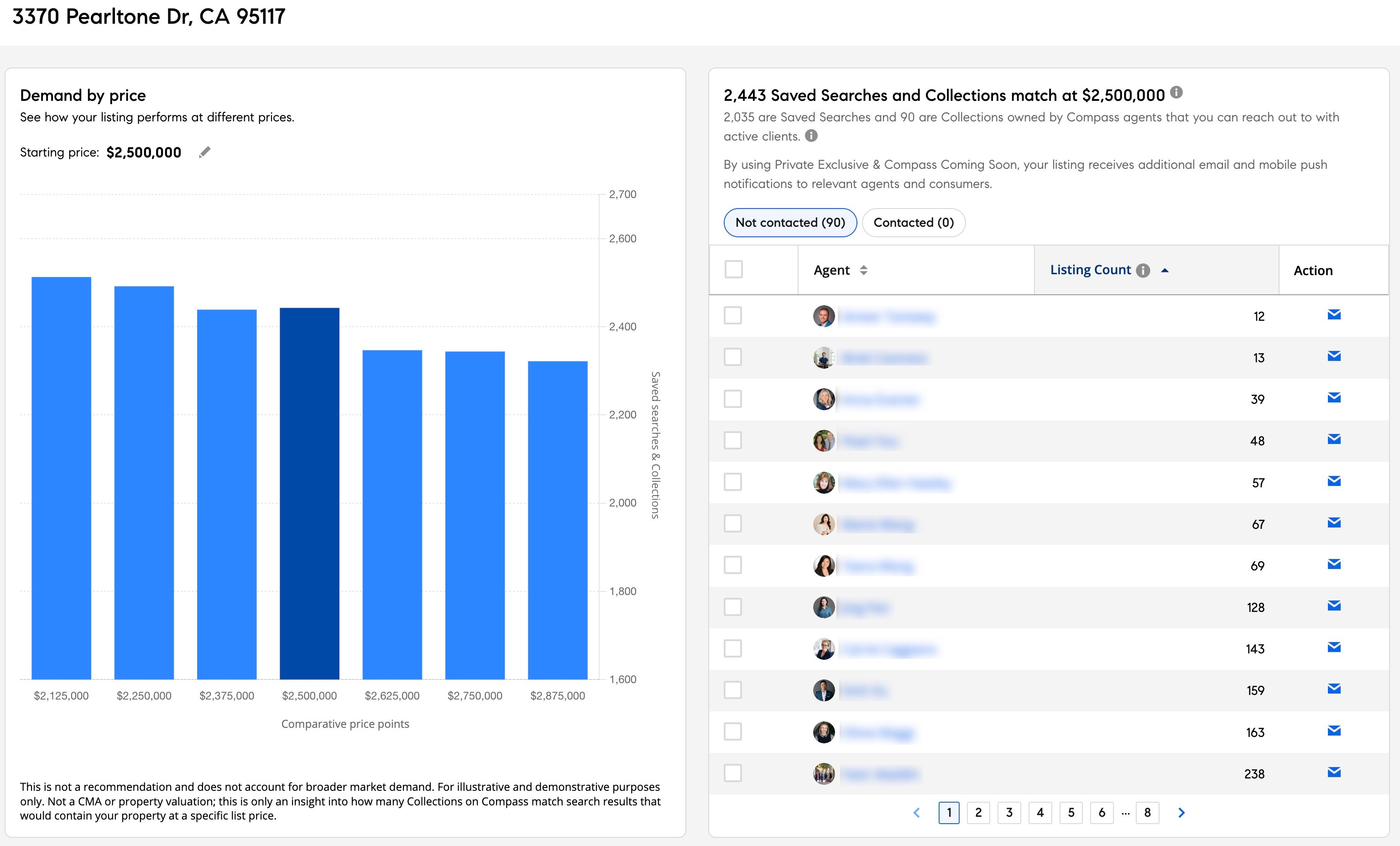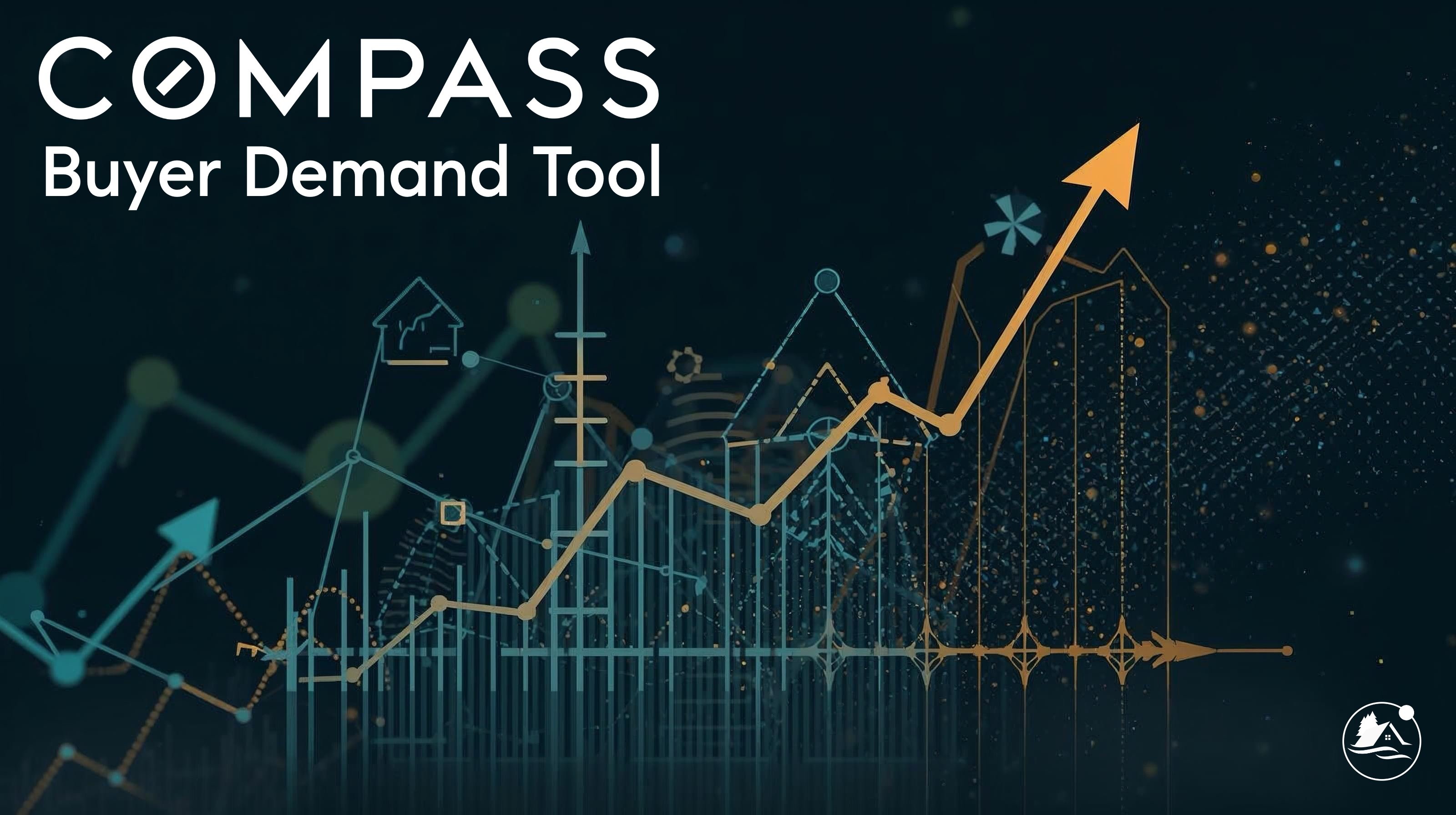In the old days — which in real estate means, like, six months ago — agents walked into listing appointments armed with “comps.” If you’ve been around the block a few times, you know what I’m talking about – it’s been this way for years: agents came armed with comparable sales, printed out and stapled together like a high-school term paper, were the gold standard for pricing a home. The problem? They only told you what has already happened. You’re basically driving by looking in the rearview mirror. It’s tried, but not very true, especially in any market which isn’t in some kind of plateau (and markets rarely stay in a plateau for very long).
Compass, never one to stay stuck in the past, has changed that with its proprietary tool called Buyer Demand — a feature that gives agents (and their sellers) live, data-driven insights into how many serious buyers are currently looking for homes like theirs. Not last month. Not last quarter. Right now.
A Shift From “Sold Data” to “Active Demand”
Here’s what makes this such a big deal. Most home price conversations start with sales that already closed — which can be weeks or even months old. Buyer Demand flips that around by showing what’s happening literally right this second: how many buyers have active searches for homes like yours, in your price range, and your neighborhood.
This lets agents walk into listing presentations “with real-time visibility into serious buyers” — which is a fancy way of saying sellers can finally see whether their home is priced in the sweet spot, or it’s way out in no-man’s-land…and what it will take to get it where found where buyers are actually looking for it.
It’s not just a shiny object. It’s a mindset shift. Real estate has always been part art, part science. Buyer Demand puts a lot more weight on the science.
How It Works: Millions of Searches, One Dashboard
The Buyer Demand tool draws from the data goldmine inside Compass’s ecosystem — millions of Saved Searches and Compass Collections, which are collaborative wish lists that buyers and agents build together. True, this does not encompass the totality of every buyer out there – but in the Bay Area, Compass controls a huge chunk of the market. And not just any chunk – the best chunk, as Compass agents are known to work with an upper-tier clientele.
Let’s say you’re selling a three-bedroom home in Los Gatos priced around $3.4 million. Your Compass agent can plug that info into Buyer Demand and instantly see how many serious buyers are looking for homes just like yours. “Serious” isn’t just a flattering adjective : it’s defined by Compass as people actively searching and saving homes on the platform, or working directly with an agent through Compass Collections.
This is where things get interesting. You can adjust the price point right there on screen and watch demand rise or fall. Maybe at $3.3 million, there are 40 active buyers, but at $3.6 million, that drops to 18. Suddenly, you’re not guessing what the market is looking for — you’re seeing it, in real time.

From Guesswork to Strategy
In an industry that loves buzzwords like “data-driven,” Compass is actually walking the walk. Buyer Demand lets agents back up their pricing recommendations with hard numbers, not gut feelings or wishful thinking.
One of the talking points the Compass marketing folks put out sums it up perfectly:
“We don’t just tell you what other homes sold for. We can show you what the current demand for your home is today at different price points, before your home even hits the market.”
That’s the difference between old-school marketing and strategic selling.
Why Sellers Should Care
If you’re thinking of selling your home, Buyer Demand offers something homeowners have always wanted but rarely get: clarity.
Ever wonder how many buyers are out there looking for a home like yours? Now you can actually see it. You’ll know whether you’re entering a market with a line of eager buyers or one where demand is thin and cautious. That knowledge helps you decide whether to push the price, hold steady, or make a move.
Compass’s data doesn’t come from national averages or theoretical models. It’s live data from people who are currently searching, saving, and scheduling showings. Think of it as a market X-ray — finally revealing what’s under the surface of all that “market chatter.”
Smart Pricing in Real Time
One of the trickiest conversations in real estate is the price adjustment. No seller wants to hear it, but sometimes the market gives feedback you can’t ignore. Buyer Demand softens that blow by turning it into a strategic conversation rather than a painful one.
The Compass Buyer Demand Tool allows sellers to see how much more exposure they could get through a price adjustment:
“The Compass Buyer Demand Tool gives us more data into a question that many sellers have always wondered, which is: ‘How many more buyers customers could we reach if we change the price to X dollars?’”
Instead of vague hand-waving, a Compass agent can show sellers a graph comparing buyer activity at two price points — your current list price versus the adjusted one. That visual speaks louder than any pep talk.
Part of a Bigger Ecosystem
Buyer Demand isn’t a standalone tool. It integrates seamlessly with the rest of the Compass tech suite — including the Compass CRM, Business Tracker, and other agent platforms.
It also complements other Compass innovations like Reverse Prospecting, which lets agents see when other Compass agents are showing or sharing your home to clients, and Compass One, the client dashboard that gives sellers a transparent view of the entire selling process. And of course, it dovetails very nicely with Compass Make Me Sell, so agents can speak intelligently with homeowners about the kind of demand we’re seeing for homes like theirs at specific price points.
Together, these tools form a kind of “smart cockpit” for agents and their clients, turning intuition into measurable insight and helping home sellers make faster, better-informed decisions.
The Three-Phase Marketing Advantage
Compass agents are also connecting Buyer Demand to what they call the Three-Phased Marketing Strategy: a smarter, more deliberate way to launch a listing.
- Private Exclusive Phase: Before going public, agents use Buyer Demand to validate the aspirational price by measuring the audience of serious buyers already in the system.
- Coming Soon Phase: The validated price generates a surge of attention from high-intent buyers whose Saved Searches match your home.
- Public Launch: By the time your home hits the MLS, the market’s already been primed with data-backed interest.
It’s like running a soft-open for a restaurant before the grand opening — except instead of testing appetizers, you’re testing price elasticity.
What Makes Buyer Demand Different
There are plenty of real estate data tools floating around. Zillow’s got its Zestimate, Redfin has its charts, and nearly every agent has some sort of market report tucked under their arm. What makes Compass’s Buyer Demand Tool stand out is that it’s first-party data — meaning it comes straight from Compass’s own ecosystem. It’s not scraped, estimated, or modeled. It’s built from real buyer behavior on the platform.
That’s a huge advantage. Compass isn’t relying on lagging indicators like sold prices or third-party MLS feeds. It’s analyzing active search data, which reflects intent — the holy grail of marketing.
When you know how many people are actively hunting for a home like yours, you’re not just reacting to the market — you’re anticipating it.
Real-World Scenarios: Turning Data Into Dollars
Imagine you’re selling a condo in San Jose. Buyer Demand shows that there are 120 buyers searching for similar condos between $800K and $850K — but only 45 at $875K. That’s not theoretical. That’s actionable intelligence.
Or suppose you’re a seller in quiet Evergreen where buyer activity seems flat. You might use Buyer Demand data to show that dropping the price by 5% could double the number of active buyers in range. That’s not a “price cut.” It’s a strategic repositioning.
In competitive markets, where homes can sit for weeks, having real-time buyer interest metrics helps agents pivot faster — before momentum fades.
Reinforcing the Role of the Agent
Compass has always positioned itself as a technology company that happens to sell real estate. The Buyer Demand tool is another proof point. But far from replacing agents, it strengthens their role as advisors. Compass CEO Robert Reffkin put it succinctly:
The Buyer Demand Tool reinforces the role of real estate professionals as trusted, data-driven advisors guiding their clients through one of life’s most important decisions.
That’s the kind of tech homeowners actually want — not to replace human expertise, but to sharpen it.
Transparency Meets Confidence
One of the biggest stress points in selling a home is uncertainty. Am I priced right? Are buyers out there? Is anyone even looking? Buyer Demand gives sellers definite answers.
For agents, it’s a presentation superpower. For sellers, it’s peace of mind. And for the industry, it’s another sign that real estate is moving toward greater transparency — powered not by hype, but by data.
The Bigger Picture: Real-Time Real Estate
With the launch of Buyer Demand, Compass is pushing the industry toward real-time real estate — where insights aren’t weeks old, and strategies adapt on the fly. It’s part of a broader trend toward immediacy in nearly every corner of life.
Just as investors track live market tickers and travelers check flight delays in real time, homeowners now expect their real estate experience to be just as dynamic. Compass is betting that live demand data will become the new normal.
With the launch of the Buyer Demand Tool, the future is here and it’s easy to see how the Compass platform is shaping it.
Final Thoughts: Knowledge Is Power — Especially When It’s Live
For years, sellers have been told “the market will tell us.” Buyer Demand means the market is talking now.
This isn’t a magic crystal ball; it won’t predict exactly what your home will sell for. But it gives sellers a sharper lens to understand buyer psychology and to act strategically. That’s priceless in a market that can turn faster than a trending topic on Instagram.
So if your agent brings up Buyer Demand, pay attention. It’s not just another digital bell-and-whistle. It’s the difference between crossing your fingers and making an informed move. Compass’s new tool doesn’t just measure interest — it measures momentum. And in real estate, momentum is everything.
Amazing Mountain View Homes for Sale
2
3
4
5
6
7
8
9
10
11
12
13
14
15
16
17
18
19
20
21
22
23
24
25





